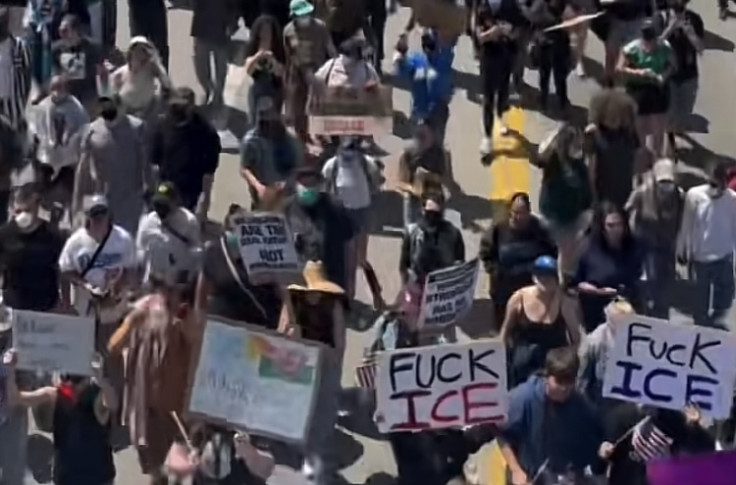Who Is ICE Going After? Trump's Immigration Crackdown Guns For 3,000 Daily as LA Protests Spark Nationwide Uproar
Massive enforcement sweeps target workers with no criminal records, fueling unrest and raising concerns about economic impact

A new wave of immigration enforcement in the United States has led to chaos on the streets of Los Angeles and fears across the nation, with the government aiming to deport thousands every day.
The focus appears to be shifting from targeted criminals to broad sweeps that include workers with no criminal history, sparking protests and violent clashes. This crackdown signals a significant escalation in a long-standing debate about immigration policy and enforcement priorities.
Weekend Chaos
Over the weekend, Los Angeles saw its streets filled with thousands protesting against what many see as aggressive and indiscriminate immigration raids. The US Immigration and Customs Enforcement (ICE) targeted workplaces with high immigrant populations, including the garment district and a Home Depot in Paramount. Reports indicate that more than 45 people were detained in LA alone, with raids focusing on workers using fake employee documents. The Department of Justice later reported that 118 arrests had been made across the city, though it's unclear how many were from workplace operations.
The raids ignited widespread unrest, with violence erupting between protesters and law enforcement. Union leader David Huerta, president of SEIU California, was among those arrested. His union claims he was observing peacefully and was injured during arrest, while officials say he interfered with officers. The union has scheduled a rally for him on Monday morning in downtown LA.
The Driving Forces Behind the Crackdown
The crackdown is reportedly driven by directives from the Trump administration, particularly from White House Deputy Chief of Staff Stephen Miller. He is said to have pushed for a policy of mass arrests, with a focus on increasing deportation numbers regardless of criminal records. ICE officials have openly discussed their goal of arresting at least 3,000 migrants daily, a figure that would constitute a significant increase over previous efforts.
White House Border Czar Tom Homan also announced that ICE would flood enforcement zones with personnel, promising more workplace raids than ever before. This approach appears designed to satisfy political pressures to appear tough on illegal immigration, even if it risks disrupting industries that rely heavily on immigrant labour.
Who Is ICE Targeting?
While the administration often frames its operations as targeting dangerous criminals, evidence suggests that many of those caught up in these raids are simply workers with no criminal record. The focus is on undocumented workers, sometimes with fictitious or fake documents, regardless of their actual behaviour or threat level. For instance, recent raids in LA involved workers at clothing stores and warehouses, some with legal immigration status or no criminal history at all.
The government's rhetoric has blurred the line between targeting illegal entry and broad deportation efforts. According to the Department of Homeland Security, the recent operations led to 118 arrests in LA, but it remains unclear how many of these individuals pose any threat beyond their immigration status. Critics argue such broad sweeps could have serious impacts on industries like construction, food services, and healthcare, which depend on immigrant workers.
The Impact on the US Workforce and Economy
Experts warn that aggressive deportation campaigns could severely damage the US economy. A 2016 report by the Centre for American Progress estimates that deporting 7 million workers would cut employment and GDP significantly, potentially sparking a recession. Industries like construction and hospitality, which employ millions of undocumented workers, could face labour shortages that slow growth and push prices higher.
Despite these warnings, polls show that a majority of Americans believe the government is mainly targeting dangerous criminals. However, recent raids have demonstrated that this is not the case, as workers with no criminal record are also being detained, stirring further anger and protests. Angelica Salas, director of the Coalition for Humane Immigrant Rights, emphasised that simply appearing as an immigrant does not make someone a criminal.
The Broader Context: A Nationwide Uprising
In Los Angeles, protests have persisted for days, with demonstrators condemning ICE's tactics. The situation escalated when President Donald Trump announced plans to deploy 2,000 National Guard troops to LA—an unprecedented move since 1965, when federal troops were sent to protect civil rights marches. Trump claimed the deployment was necessary to control chaos, but California's governor, Gavin Newsom, called the move an escalation that risks inflaming tensions further.
The use of the National Guard without local approval is highly unusual and has drawn criticism from officials and activists alike. Governor Newsom has formally demanded the withdrawal of the troops, warning that their presence could worsen the unrest. Despite claims from some Republicans that protests have been subdued, reports indicate ongoing demonstrations and clashes, with no clear end in sight.
Who Are the Real Targets?
While the government insists its focus is on criminal elements, evidence suggests that broad sweeps are ensnaring workers simply for their immigration status. The focus on workplaces is part of a wider strategy that has been used in previous administrations but now appears to be intensified under Trump's policies.
Critics argue that these tactics sow fear in immigrant communities and threaten essential industries. As Salas pointed out, someone's appearance or their use of fake documents should not automatically label them as criminals. Meanwhile, the economic and social toll of such enforcement grows, with many questioning whether the benefits outweigh the costs.
© Copyright IBTimes 2025. All rights reserved.





















